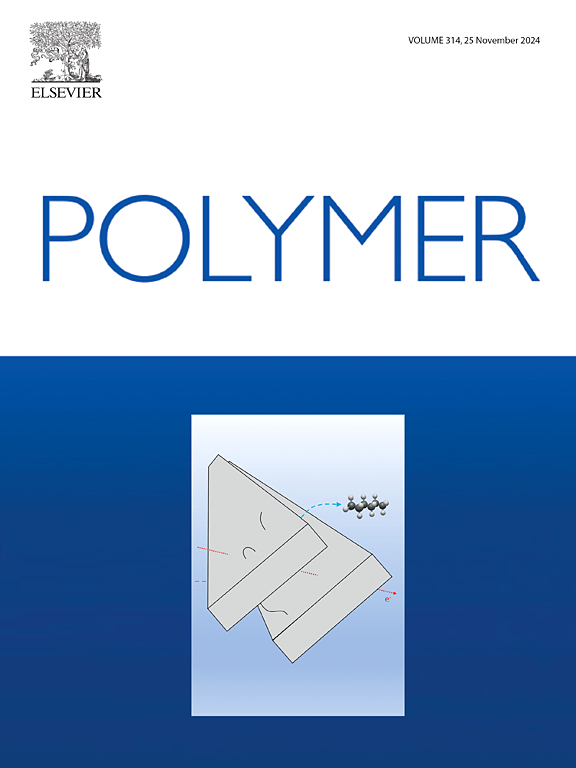本征导热超高分子量聚乙烯通过循环脉动压力
IF 4.1
2区 化学
Q2 POLYMER SCIENCE
引用次数: 0
摘要
电子器件的小型化、集成化和性能增强推动了对高效热管理的迫切需求。其中,超高分子量聚乙烯(UHMWPE)由于其固有的高比强度和理论上超高的固有导热系数,一旦对其链结构进行定制,可以被认为是一个有希望的候选者。然而,目前制备本征导热超高分子量聚乙烯的方法需要进行复杂的后处理,以便沿着机器方向进行极端拉伸,并且只能用作薄膜和纤维。本文在UHMWPE的压缩成型过程中引入了循环脉动压力(CPP),并首次提出了一种单步制备本征导热UHMWPE板材的方法。研究了不同CPP条件下晶体结构和分子链的演变规律,结果表明,CPP过程中适当选择关闭周期(Toff)可以改变其结构。结果表明,制备的超高分子量聚乙烯的热导率明显提高,从传统薄片的0.619 W/mK提高到优化Toff条件下的3.91 W/mK,这可以认为是由于晶体的面内排列。最终,我们的新型固有导热超高分子量聚乙烯片材被用来传递LED的热量,以显示其作为导热材料的能力。我们相信这项工作不仅可以提供高导热聚合物片材及其制造方案,还可以为UHMWPE的动压诱导结构演变提供基本的见解。本文章由计算机程序翻译,如有差异,请以英文原文为准。


Intrinsic thermal conductive ultra-high molecular weight polyethylene via cyclic pulsating pressure
The miniaturization, integration, and performance enhancement of electronic devices have driven an urgent demand for efficient thermal management. Among which, ultra-high molecular weight polyethylene (UHMWPE) could be considered as a promising candidate due to its inherent high specific strength and theoretically ultra-high intrinsic thermal conductivity, once its chain structure been tailored. However, current methods for preparing intrinsic thermally conductive UHMWPE requires complex post-treatment for the extreme-stretching along machine direction, and can only employed as film and fibers. In this work, we introduce cyclic pulsating pressure (CPP) during the compression molding of UHMWPE, and for the first time, proposed a single-step method for fabricating intrinsic thermally conductive UHMWPE sheet. The evolutions in crystalline structure and molecular chains with different CPP conditions have been comprehensively investigated, and the results suggest that its structural changes with proper selection of the pressure-off period (Toff) in CPP process. Consequently, the as-prepared UHMWPE shows obviously enhancement in its thermal conductivity from 0.619 W/mK for conventional sheet to 3.91 W/mK for the one under CPP with optimized Toff, which is then considered due to the in-plane alignment of crystals. Ultimately, our novel intrinsic thermally conductive UHMWPE sheet was employed to transfer the heat from LED to show its ability as thermal conductive materials. We believe that this work can not only provide a highly thermal conductive polymer sheet with its fabrication protocol, but also supply fundamental insight around the dynamic pressure induced structural evolutions of UHMWPE.
求助全文
通过发布文献求助,成功后即可免费获取论文全文。
去求助
来源期刊

Polymer
化学-高分子科学
CiteScore
7.90
自引率
8.70%
发文量
959
审稿时长
32 days
期刊介绍:
Polymer is an interdisciplinary journal dedicated to publishing innovative and significant advances in Polymer Physics, Chemistry and Technology. We welcome submissions on polymer hybrids, nanocomposites, characterisation and self-assembly. Polymer also publishes work on the technological application of polymers in energy and optoelectronics.
The main scope is covered but not limited to the following core areas:
Polymer Materials
Nanocomposites and hybrid nanomaterials
Polymer blends, films, fibres, networks and porous materials
Physical Characterization
Characterisation, modelling and simulation* of molecular and materials properties in bulk, solution, and thin films
Polymer Engineering
Advanced multiscale processing methods
Polymer Synthesis, Modification and Self-assembly
Including designer polymer architectures, mechanisms and kinetics, and supramolecular polymerization
Technological Applications
Polymers for energy generation and storage
Polymer membranes for separation technology
Polymers for opto- and microelectronics.
 求助内容:
求助内容: 应助结果提醒方式:
应助结果提醒方式:


